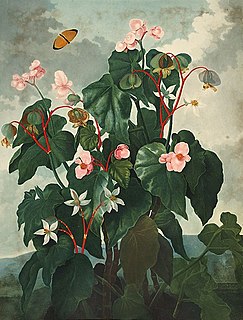
Begonia is a genus of perennial flowering plants in the family Begoniaceae. The genus contains more than 2,000 different plant species. The Begonias are native to moist subtropical and tropical climates. Some species are commonly grown indoors as ornamental houseplants in cooler climates. In cooler climates some species are cultivated outside in summertime for their bright colorful flowers, which have sepals but no petals.

The geography of Malaysia includes both the physical and the human geography of Malaysia, a Southeast Asian country made up of two major landmasses separated by water—Peninsular Malaysia to the west and East Malaysia to the east—and numerous smaller islands that surround those landmasses. Peninsular Malaysia is on the southernmost part of the Malay Peninsula, south of Thailand, north of Singapore and east of the Indonesian island of Sumatra; East Malaysia comprises most of the northern part of Borneo island, and shares land borders with Brunei to the north and Indonesian Borneo to the south.

Olea is a genus of about 40 species in the family Oleaceae, native to warm temperate and tropical regions of the Middle East, southern Europe, Africa, southern Asia, and Australasia. They are evergreen trees and shrubs, with small, opposite, entire leaves. The fruit is a drupe. Leaves of Olea contain trichosclereids.

Belaga is a district in Kapit Division, Sarawak, Malaysia. It is located on the upper reaches of the Rajang River, some 120 kilometers northeast of Kapit and slightly less than 100 kilometers from the South China Sea coast near Bintulu. It is located within the Hulu Rajang parliamentary constituency.

The Malayan tiger is a tiger from a specific population of the Panthera tigris tigris subspecies that is native to Peninsular Malaysia. This population inhabits the southern and central parts of the Malay Peninsula and has been classified as critically endangered on the IUCN Red List since 2015. As of April 2014, the population was estimated at 80 to 120 mature individuals with a continuous declining trend.
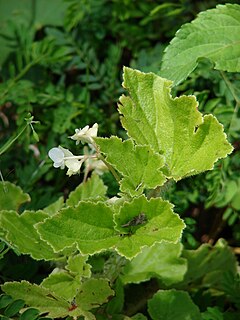
Begoniaceae is a family of flowering plants with two genera and about 2040 species occurring in the subtropics and tropics of both the New World and Old World. All but one of the species are in the genus Begonia. There have been many recent discoveries of species in the genus Begonia, such as Begonia truncatifolia which is endemic to San Vincente, Palawan. B. truncatifolia is smaller in size than other species of the genus Begonia and this new species is proposed Critically Endangered by standards set by the IUCN. The only other genus in the family, Hillebrandia, is endemic to the Hawaiian Islands and has a single species. Phylogenetic work supports Hillebrandia as the sister taxon to the rest of the family. The genus Symbegonia was reduced to a section of Begonia in 2003, as molecular phylogenies had shown it to be derived from within that genus. Members of the genus Begonia are well-known and popular houseplants.

Kalophrynus is a genus of microhylid frogs. It is the only genus in the subfamily Kalophryninae. The species in this genus are found in southern China, in Southeast Asia to Java and Philippines, and in Assam, India.

Bukit Larut is a hill resort in Malaysia located in the state of Perak, Malaysia, 10 kilometres southwest from Taiping. It was established under the direction of British colonists in 1884 as a place of observation for tin mining activity and as a retreat for the English people who were based in nearby Larut and Taiping. The area was initially named Maxwell Hill after the British Malaya administrator George Maxwell, and was renamed as Bukit Larut in 1979.

Nepenthes benstonei is a tropical pitcher plant endemic to Peninsular Malaysia, where it grows at elevations of 150–1350 m above sea level. The specific epithet benstonei honours botanist Benjamin Clemens Stone, who was one of the first to collect the species.

Hanguana is a genus of flowering plants with a dozen known species. It is the only genus in the family Hanguanaceae.
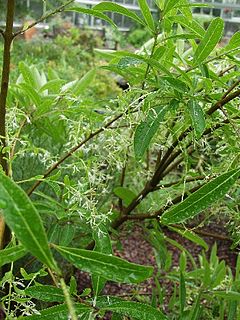
Chionanthus, common name: fringetrees, is a genus of about 150 species of flowering plants in the family Oleaceae.

Nepenthes alba is a tropical pitcher plant endemic to Peninsular Malaysia. The specific epithet alba is derived from the Latin word albus, meaning "white", and refers to the colour of the upper pitchers.
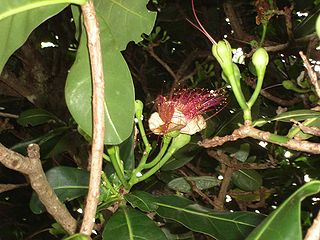
Barringtonia is a genus of flowering plants in the family Lecythidaceae first described as a genus with this name in 1775. It is native to Africa, southern Asia, Australia, and various islands of the Pacific and Indian Oceans. The genus name commemorates Daines Barrington.
The Malesian frog, Malaysian river frog, Malaysian peat frog, or peat swamp frog is a species of frog in the family Dicroglossidae. It is found on the Malay Peninsula, Sumatra, Java, Borneo, and a range of islands on the Sunda Shelf . Its natural habitats are shallow, gentle streams and nearby swampy areas including peat swamps, very flat alluvial forests, and overgrown plantations. It is becoming rare due to habitat loss (deforestation), and to a lesser extent, exploitation.
Begonia eiromischa, commonly known as woolly-stalked begonia, is a presumed extinct plant from Malaysia.

The environment of Malaysia is the biotas and geologies that constitute the natural environment of Malaysia. Malaysia's ecology is megadiverse, with a biodiverse range of flora and fauna found in various ecoregions throughout the country. Tropical rainforests encompass between 59% to 70% of Malaysia's total land area, of which 11.6% is pristine. Malaysia has the world's fifth largest mangrove area, which totals over a half a million hectares.

Peninsular Malaysia (Malay: Semenanjung Malaysia), also known as West Malaysia or the Malaysian Peninsula, formerly known as Malaya, is the part of Malaysia which occupies the southern half of the Malay Peninsula in Southeast Asia and the nearby islands. Its area totals 132,265 km2 (51,068 sq mi), which is nearly 40% of the total area of the country; the other 60% is East Malaysia. For comparison, it is slightly larger than England (130,395 Km2). It shares a land border with Thailand to the north.
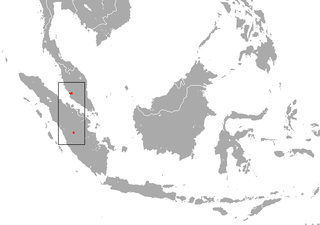
The orbiculus leaf-nosed bat, also known as the orbiculus roundleaf bat and small disc roundleaf bat, is a species of bat from the family Hipposideridae. The species has been found on the island of Sumatra in Indonesia and on peninsular Malaysia.

The Greater Ulu Muda Forest Complex (GUMFC) is a large expanse of lowland dipterocarp forest in the north of Kedah State, Malaysia, on the border with Thailand. The area has high biodiversity thanks to relatively low rates of poaching and human intrusion. A number of endangered species are known to be present in the GUMFC. The forest is in the Peninsular Malaysian rain forests ecoregion.
















